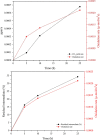Photocatalytic Oxidation of PLA/TiO2-Composite Films for Indoor Air Purification
- PMID: 34056216
- PMCID: PMC8153744
- DOI: 10.1021/acsomega.0c06194
Photocatalytic Oxidation of PLA/TiO2-Composite Films for Indoor Air Purification
Abstract
Non-decomposable plastic has been replaced with polylactic acid, which is a biodegradable aliphatic polyester stationary phase, in composite films embedded with a TiO2 photocatalyst for mitigation of indoor air pollution. PLA has superior properties relative to those of other biopolymers, such as a relatively high melting point, crystallinity, and rigidity. This study aimed to incorporate TiO2-anatase into PLA for use as a photocatalyst using the blown film method. Photocatalytic oxidation, an advanced oxidative process, has been recognized as an economical technique providing convenience and efficiency with indoor air treatment. Therefore, the use of new environmentally friendly biodegradable polymers provides an alternative way to address the severe environmental concerns caused by non-decomposable plastics. UV-vis spectrophotometry and scanning electron microscopy-energy-dispersive X-ray spectroscopy (SEM-EDX) were used to observe the dispersibility and mixing capacity of the TiO2-anatase PLA matrix. TiO2 dosages were 5, 10, and 15% (wt/wt), and they were incorporated with a twin-screw extruder. SEM-EDX images demonstrated the homogeneity of TiO2 distribution in the PLA matrix. The energy band gaps of TiO2 in the PLA/TiO2-composite films were between 3.14 and 3.22 eV. The relationship between the photocatalytic oxidation rate and the TiO2 dosage in the PLA/TiO2-composite films was determined. A prototype reactor model is geared toward the development of air purifiers for indoor air conditioning. Rate constants for benzene degradation were obtained using first-order kinetics to find rate constants matching experimental findings. In the PLA/TiO2-composite film, the TiO2-anatase photocatalyst was able to degrade 5 ppm benzene. This work contributes to the use of ecoefficient photocatalytic oxidation.
© 2021 The Authors. Published by American Chemical Society.
Conflict of interest statement
The authors declare no competing financial interest.
Figures







Similar articles
-
Next-Generation Eco-Friendly Hybrid Air Purifier: Ag/TiO2/PLA Biofilm for Enhanced Bioaerosols Removal.Int J Mol Sci. 2025 May 10;26(10):4584. doi: 10.3390/ijms26104584. Int J Mol Sci. 2025. PMID: 40429732 Free PMC article.
-
Application of nano-TiO2/LDPE composite film on photocatalytic oxidation degradation of dichloromethane.J Environ Biol. 2012 Sep;33(5):955-9. J Environ Biol. 2012. PMID: 23734465
-
Natural rubber modification as a pre-vulcanized latex impregnated with TiO2 for photo-catalytic degradation of gaseous benzene.Heliyon. 2020 May 8;6(5):e03912. doi: 10.1016/j.heliyon.2020.e03912. eCollection 2020 May. Heliyon. 2020. PMID: 32420484 Free PMC article.
-
Transparent TiO2 thin films with high photocatalytic activity for indoor air purification.RSC Adv. 2022 Dec 12;12(55):35531-35542. doi: 10.1039/d2ra06488j. eCollection 2022 Dec 12. RSC Adv. 2022. PMID: 36540401 Free PMC article.
-
Review of Recent Advances in Polylactic Acid/TiO2 Composites.Materials (Basel). 2019 Nov 7;12(22):3659. doi: 10.3390/ma12223659. Materials (Basel). 2019. PMID: 31703262 Free PMC article. Review.
Cited by
-
Using visible light to activate antiviral and antimicrobial properties of TiO2 nanoparticles in paints and coatings: focus on new developments for frequent-touch surfaces in hospitals.J Coat Technol Res. 2023;20(3):789-817. doi: 10.1007/s11998-022-00733-8. Epub 2023 Feb 7. J Coat Technol Res. 2023. PMID: 36777289 Free PMC article. Review.
-
Synthesis and Characterization of Cellulose Diacetate-Graft-Polylactide via Solvent-Free Melt Ring-Opening Graft Copolymerization.Polymers (Basel). 2022 Dec 28;15(1):143. doi: 10.3390/polym15010143. Polymers (Basel). 2022. PMID: 36616493 Free PMC article.
-
Next-Generation Eco-Friendly Hybrid Air Purifier: Ag/TiO2/PLA Biofilm for Enhanced Bioaerosols Removal.Int J Mol Sci. 2025 May 10;26(10):4584. doi: 10.3390/ijms26104584. Int J Mol Sci. 2025. PMID: 40429732 Free PMC article.
References
-
- Hallett S.; Toro F.; Ashurst J. V.. Physiology, Tidal Volume [Online]; StatPearls Publishing: Treasure Island, FA, 2020; pp. 1–15. https://www.ncbi.nlm.nih.gov/books/NBK482502/?report=reader (access Dec 10, 2020). - PubMed
-
- Klepeis N. E.; Nelson W. C.; Ott W. R.; Robinson J. P.; Tsang A. M.; Switzer P.; Behar J. V.; Hern S. C.; Engelmann W. H. The National Human Activity Pattern Survey (NHAPS): a resource for assessing exposure to environmental pollutants. J. Expo. Sci. Environ. Epidemiol. 2001, 11, 231–252. 10.1038/sj.jea.7500165. - DOI - PubMed
LinkOut - more resources
Full Text Sources
Other Literature Sources

